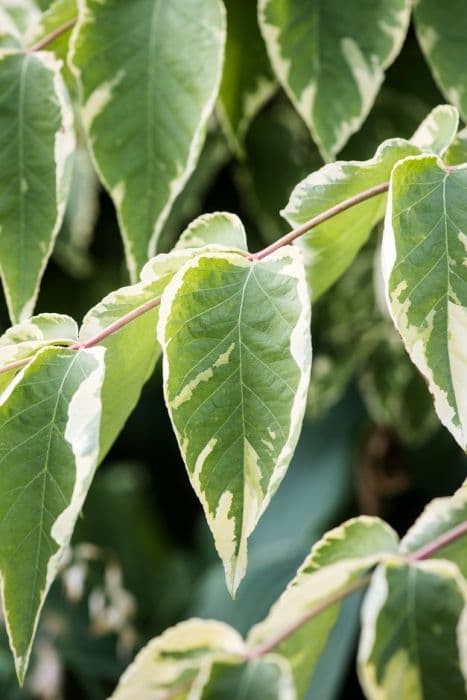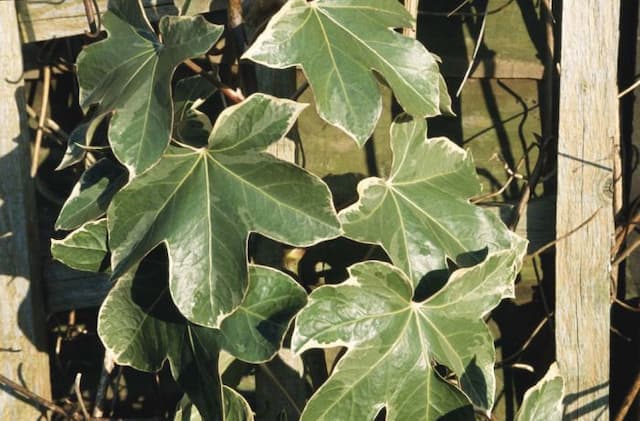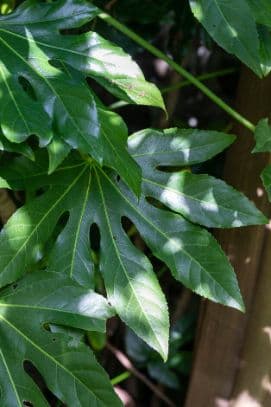Tree ivy × Fatshedera lizei 'Annemieke' (v)

ABOUT
× Fatshedera lizei 'Annemieke' (v), commonly known as the tree ivy, is a unique intergeneric hybrid that displays both shrub and vine-like characteristics from its parentage. This particular cultivar, 'Annemieke,' features variegated foliage, which adds a captivating visual interest. The leaves are heart-shaped, large, and have a glossy surface that showcases shades of green with irregular creamy yellow to white margins. Each individual leaf on the 'Annemieke' can display a unique pattern of variegation, contributing to the plant's ornamental appeal. The plant possesses a semi-woody structure, giving it a sturdy and robust appearance. Branches tend to spread and can be trained to grow in a particular direction or left to develop in a more natural, semi-climbing form. The 'Annemieke' variant is less vigorous than the species, making its spread and form a bit tamer and more suitable for ornamental use in various settings without overwhelming the space. The foliage is the most striking feature of this plant, with the variegation providing a lively contrast against the more uniformly green backdrop of a garden or indoor setting.
About this plant
 Names
NamesFamily
Araliaceae.
Synonyms
Tree Ivy, Aralia Ivy, Ivy Tree, Fatshedera, Botanical Wonder.
Common names
× Fatshedera lizei 'Annemieke' (v).
 Toxicity
ToxicityTo humans
The Tree Ivy is generally considered to have a low level of toxicity to humans, but it can still cause some unpleasant symptoms if ingested. The most common symptoms of poisoning from this plant may include irritation of the mouth and gastrointestinal tract, which can lead to nausea, vomiting, and diarrhea. In some cases, skin contact with the sap can also cause dermatitis. It's important to be cautious and avoid ingesting any part of the plant to prevent these potential consequences.
To pets
The Tree Ivy can be toxic to pets if ingested. Symptoms of poisoning in animals can include vomiting, diarrhea, and drooling, due to the irritation of the mouth and gastrointestinal tract. In some severe cases, pets might also exhibit signs of depression or a decrease in appetite. It is crucial to prevent pets from chewing on or ingesting any part of the plant to avoid these adverse health effects.
 Characteristics
CharacteristicsLife cycle
Perennials
Foliage type
Evergreen
Color of leaves
Variegated
Height
4-5 feet (1.2-1.5 meters)
Spread
2-3 feet (0.6-0.9 meters)
Plant type
Shrub
Hardiness zones
8-11
Native area
Hybrid
Benefits
 General Benefits
General Benefits- Easy to Grow: × Fatshedera lizei 'Annemieke' (v), commonly known as tree ivy, is relatively easy to care for and can thrive under a variety of conditions, making it suitable for gardeners of all levels.
- Versatile in Design: Tree ivy can be used in various design schemes, including formal gardens, casual, or cottage-style landscapes.
- Variegated Foliage: Tree ivy has attractive variegated leaves that add visual interest and contrast to garden settings or indoor plant collections.
- Adaptability: This plant can adapt to both indoor and outdoor environments, making it versatile for different living spaces and garden areas.
- Hybrid Vigour: Being a hybrid, tree ivy often benefits from hybrid vigour, resulting in a robust, healthy plant that can resist pests and diseases better than some pure species.
- Space Filler: With its bushy, spreading habit, tree ivy is excellent for filling spaces in the landscape, providing ground cover, or creating a substantial presence in a room.
- Seasonal Interest: Tree ivy offers year-round interest with its evergreen leaves, making it an excellent choice for gardeners looking to maintain some greenery throughout the seasons.
- Support for Wildlife: While it is not a major wildlife attractant, tree ivy can provide shelter and habitat for various insects and small animals when planted outdoors.
- Low Maintenance: Tree ivy generally requires minimal maintenance, helping gardeners save time and effort in taking care of this plant.
 Medical Properties
Medical PropertiesThis plant is not used for medical purposes.
 Air-purifying Qualities
Air-purifying QualitiesThis plant is not specifically known for air purifying qualities.
 Other Uses
Other Uses- As a living privacy screen, Fatshedera lizei 'Annemieke' can be trained to grow along a trellis or fence, creating beautiful and thick foliage coverage that provides privacy from neighbors or passersby.
- Integrated into a sensory garden, the varied texture of its leaves can offer a tactile experience for visitors, making it especially appealing in gardens designed for the visually impaired.
- In urban environments, this plant can be used to soften hardscapes, its sprawling growth habit helping to introduce greenery onto concrete-heavy patios or balconies.
- Utilized as a living curtain inside homes or conservatories, it can provide a natural partition between different areas without requiring built structures.
- As a foil to highlight seasonal flowers, the variegated leaves of Fatshedera lizei 'Annemieke' contrast well against colorful annuals and perennials in mixed garden beds.
- Instructed in bonsai art, the bushy plant can be trained and pruned to create miniature tree-like structures that blend the aesthetics of both its parent species.
- Employed in theatrical productions or photo shoots, this plant can be used as a set decoration to create or enhance a particular mood or setting.
- As an educational tool in schools, it can be used to teach children about hybrid plants and the basics of plant care and horticulture.
- In cut flower arrangements, branches of Fatshedera lizei 'Annemieke' make lasting, attractive foliage that supports floral displays without wilting quickly.
- As a natural art medium, artists can use the leaves for making leaf prints or for pressing into flat, preserved specimens for various types of artwork.
Interesting Facts
 Feng Shui
Feng ShuiThe plant name × Fatshedera lizei 'Annemieke' is not used in Feng Shui practice.
 Zodiac Sign Compitability
Zodiac Sign CompitabilityThe plant name × Fatshedera lizei 'Annemieke' is not used in astrology practice.
 Plant Symbolism
Plant Symbolism- Innovation: × Fatshedera lizei 'Annemieke', also known as Tree Ivy, is a hybrid plant, representing the innovation and creativity that results from combining different elements effectively.
- Versatility: As Tree Ivy can adapt to indoor and outdoor environments, it symbolizes flexibility and the ability to thrive in various conditions.
- Growth: The climbing nature of Tree Ivy signifies continual growth, progress, and the pursuit of personal development.
- Protection: In alignment with the ivy in its parentage, Tree Ivy may carry the symbolism of protection and safekeeping, as ivies are often associated with sheltering and encompassing qualities.
 Water
WaterThe Tree Ivy 'Annemieke', a hybrid plant, prefers to be watered when the top inch of soil feels dry to the touch. It's generally best to water this plant thoroughly until water drains out of the bottom of the pot, which might occur approximately every 7 to 10 days, depending on environmental conditions. During active growth in spring and summer, water with about one to two gallons every week or week and a half, reducing to every two weeks in the fall and winter. Overwatering can lead to root rot, so ensure the pot has good drainage and the soil is not left soggy.
 Light
LightTree Ivy 'Annemieke' thrives in bright, indirect light but can also tolerate partial shade. Avoid direct sunlight as it can scorch the leaves. A north-facing window or a spot that receives filtered light through a sheer curtain in an east- or west-facing room would be ideal. Keeping the plant in too much shade may result in leggy growth.
 Temperature
TemperatureTree Ivy 'Annemieke' prefers a temperature range of 65 to 75 degrees Fahrenheit for optimal growth but can survive in temperatures as low as 50 and as high as 80 degrees Fahrenheit. Protect the plant from drafts and sudden temperature changes to prevent stress. This plant does not tolerate frost, so it should not be exposed to temperatures below 50 degrees Fahrenheit.
 Pruning
PruningTree Ivy 'Annemieke' benefits from pruning to maintain its shape and encourage bushier growth. Prune in the spring before the onset of new growth, generally every year or when the plant looks overgrown. Remove any dead or damaged branches, and cut back to just above a leaf node to promote new shoots. Regular pruning will also help the plant to invest more energy into the healthy foliage.
 Cleaning
CleaningAs needed
 Soil
SoilThe Tree Ivy 'Annemieke' prefers a well-draining potting soil mix that contains peat, perlite, and compost to retain some moisture while preventing root rot. A slightly acidic to neutral soil pH of 6.0 to 7.0 is ideal for this hybrid plant.
 Repotting
RepottingTree Ivy 'Annemieke' should be repotted every 2 to 3 years or when it becomes root-bound. Spring is the best time for repotting to minimize stress on the plant.
 Humidity & Misting
Humidity & MistingTree Ivy 'Annemieke' thrives best in moderate to high humidity levels, ranging from 40% to 60%. Ensure the humidity around the plant is maintained to promote healthy growth.
 Suitable locations
Suitable locationsIndoor
Place Tree Ivy 'Annemieke' near a window with bright, indirect light.
Outdoor
Protect Tree Ivy 'Annemieke' from harsh sun; partial shade is best.
Hardiness zone
7-10 USDA
 Life cycle
Life cycle× Fatshedera lizei 'Annemieke' (v), also known as tree ivy 'Annemieke', begins its life as a seed, although it is more commonly propagated by cuttings. Once a suitable environment with moist soil and partial shade is established, germination or rooting takes place. The plant, exhibiting its characteristic variegated leaves, enters a period of vegetative growth where it increases in size and produces stems that may require support or will trail if allowed. After reaching maturity, which can take a few years, tree ivy 'Annemieke' may produce small, insignificant flowers, although flowering is rare in this hybrid. The plant does not produce viable seeds due to its hybrid nature, so propagation is solely vegetative. As a perennial, it can live for many years, with its life cycle sustained through regular pruning and maintenance.
 Propogation
PropogationPropogation time
Spring to Summer
The × Fatshedera lizei 'Annemieke', commonly known as tree ivy 'Annemieke', is typically propagated through stem cuttings. This popular method involves taking a cutting of about 4 to 6 inches (10 to 15 centimeters) in length from a healthy parent plant, preferably during the growing season, which is spring through early summer. The bottom leaves are removed to reveal a clean section of stem, which can then be dipped in rooting hormone powder to encourage root development. The prepared cutting is then inserted into a pot filled with a well-draining potting mix, ensuring that the leaf nodes where the leaves were removed are buried in the soil as this is where roots will form. The soil should be kept moist, and the pot placed in a warm spot with indirect light until roots have established, which can take several weeks. Once rooted, the new plant can be gradually acclimated to its permanent location.









